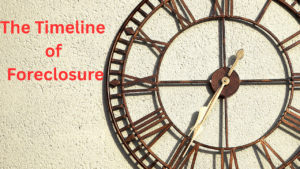 Understanding the Timeline of Foreclosure: What to Expect and When
Understanding the Timeline of Foreclosure: What to Expect and When
A Step-by-Step Guide to the Timeline of Foreclosure in the Home Repossession Process
Facing foreclosure can be overwhelming—especially when you don’t know what to expect or how quickly events can unfold. The foreclosure process varies by state, but in general, there is a predictable sequence of events that leads from a missed mortgage payment to a home being repossessed.
Understanding the timeline of foreclosure is crucial. The more you know about what happens and when, the better chance you have to act, seek help, and possibly stop the process before it’s too late.
The Timeline of Foreclosure
Stage 1: Missed Mortgage Payments (Day 1–30)
Foreclosure begins with a missed payment. Most lenders consider a payment “late” if it’s more than 15 days past due. At that point, you’ll likely receive:
- A late fee (typically 4–5% of the monthly payment)
- A notice of late payment
- Increased phone calls and letters from your lender
Key Tip: You are not in foreclosure yet. If you contact your lender at this stage, you may still qualify for forbearance, repayment plans, or loan modifications.
Stage 2: 30–60 Days Past Due – Collections Begin
If you miss two payments, your loan is considered seriously delinquent. Your lender’s collections department will likely increase efforts to reach you.
At this stage:
- You may receive formal written warnings
- Your credit report will reflect delinquency
- Your lender may begin discussing loss mitigation options
Still, foreclosure is not automatic—you still have time to explore alternatives.
Stage 3: 90 Days Past Due – Notice of Default (NOD) or Legal Action
At around 90 days delinquent, the lender typically issues a Notice of Default (NOD) in states that require it. In judicial foreclosure states, this is when the lender files a lawsuit to begin the foreclosure process.
Depending on your state:
- You may receive a NOD (non-judicial states like California)
- Or a summons and complaint (judicial states like Florida or New York)
- You usually have 20–30 days to respond
Act fast! This is the moment when you should absolutely contact a housing counselor, legal aid, or foreclosure attorney if you haven’t already.
Stage 4: Pre-Foreclosure Period – Up to 120 Days
Before a foreclosure sale can happen, federal law (under the CFPB Mortgage Servicing Rule) generally requires a 120-day waiting period after the first missed payment.
During this time:
- You can apply for loss mitigation options
- The lender cannot sell your home while your application is being reviewed
- If approved, the foreclosure process is paused or canceled
This is your best window to save your home.
Stage 5: Notice of Sale (Day 120+)
If no resolution is reached, the lender moves forward with foreclosure. This step looks different based on your state’s laws.
- In non-judicial states, the lender records a Notice of Trustee Sale or Notice of Sale
- In judicial states, the court grants a judgment of foreclosure, and the home is scheduled for auction
Notice periods vary by state:
- California: 21-day notice required before the sale
- Georgia: As little as 30 days after default
- Florida: Court-supervised sale after a final judgment
Stage 6: Foreclosure Sale or Auction
At this stage, your property is auctioned to the highest bidder or repossessed by the bank if there are no offers.
Once the sale occurs:
- You may be required to vacate the property within days or weeks
- In some states, you may still have a right of redemption (a chance to buy back your home)
- Your lender may seek a deficiency judgment if the sale doesn’t cover the mortgage balance
Stage 7: Eviction and Post-Sale Period
After the auction, the new owner (often the bank) must legally remove you from the home if you haven’t already left.
This can involve:
- A notice to vacate
- A formal eviction process
- Sheriff involvement in some states
If your state offers a post-sale redemption period, you might still have legal options—but time is short.
Quick Timeline of Foreclosure Summary
| Timeline | Stage |
|---|---|
| Day 1 | Missed mortgage payment |
| Day 30 | Loan considered delinquent |
| Day 60 | Increased collections efforts |
| Day 90 | Notice of Default / Foreclosure suit begins |
| Day 120+ | Notice of Sale issued |
| 30–60 days later | Foreclosure auction occurs |
| Post-sale | Eviction process begins |
Every State Is Different with Its Timeline of Foreclosure
While this timeline offers a general outline, your exact foreclosure process depends on:
- Whether your state uses judicial or non-judicial foreclosure
- Whether you have federal loan protections (FHA, VA, USDA)
- If your state has redemption periods or bans deficiency judgments
Check your state laws or use our Foreclosure Glossary to learn more about your rights where you live.
The Timeline of Foreclosure: Final Thoughts
Foreclosure doesn’t happen overnight—but it can feel that way if you’re caught off guard. Knowing the foreclosure timeline helps you plan ahead, communicate with your lender, and take advantage of every legal protection available.
The earlier you act, the more options you’ll have. Use this timeline as a guide—but more importantly, don’t wait until the clock runs out. If you’re at risk of foreclosure, explore our Foreclosure Help & Advice section or connect with a HUD-approved housing counselor today.